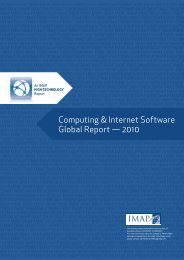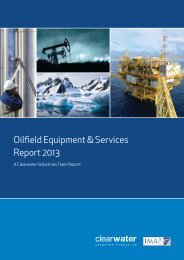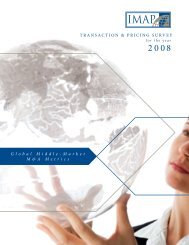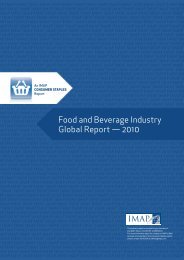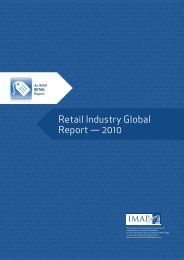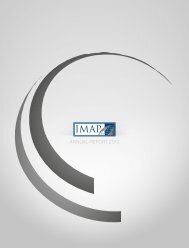IMAP Pharmaceuticals and Biotech Industry Report - 2012
IMAP Pharmaceuticals and Biotech Industry Report - 2012
IMAP Pharmaceuticals and Biotech Industry Report - 2012
Create successful ePaper yourself
Turn your PDF publications into a flip-book with our unique Google optimized e-Paper software.
CHRISTOPH BIERIDear Reader,This report is the annual review of M&A activity in the Global Pharma <strong>and</strong> <strong>Biotech</strong> industry,provided by <strong>IMAP</strong>’s Healthcare team. Its intent is to provide you with the interpretationsof events in the industry that we developed while advising clients in transactionsaround the globe. We believe that in times of great changes <strong>and</strong> uncertainty (as we arecurrently experiencing in the industry), insights based on h<strong>and</strong>s-on experience are particularlyhelpful.On page 3, you will find our analysis of deal activity in 2011. Last year brought a significantincrease in transactions ranging from US$100 million to US$500 million, compared to2010. Other observations are the continuing consolidation in China; very high valuationsfor R&D-driven transactions; <strong>and</strong> a strategic reshuffle in the future market for biosimilars,with some unexpected players appearing on the scene.We examined one of the R&D-driven deals – Gilead’s acquisition of Pharmasset – moreclosely, <strong>and</strong> find it to be an interesting case that shows how market dynamics, scientificachievements, <strong>and</strong> the need for strategic repositioning of the players in the field can overheata bidding process, leading to stunning valuations (page 9).On page 16, we discuss a comprehensive analysis of mid-term market growth that appearedlast year. Our conclusions are slightly different than those of the of the study’s authors,the IMS Healthcare institute (page 16 ). In our view, the data suggest that, in the nextfive years, the Pharma Market in mature economies will contract for the first time in history.This prospect increases the consolidation pressure, <strong>and</strong> also fuels the transformationof the industry. The automotive sector may show where this trend could lead, as McKinsey,the consultancy, suggested in a much-quoted article at the end of last year (see page 18).There is consensus that future growth in the Pharma <strong>Industry</strong> will mainly come fromemerging markets, most notably China; by introducing health insurance to 90 percent ofthe Chinese population, a market of more than 1 billion individuals was created withinjust two years. In our focus article, Pharma <strong>Industry</strong> Expert Yu Jingyi from <strong>IMAP</strong> in Chinaoutlines what foreign Pharma companies entering China will face.TABLE OF CONTENTS2011 in ReviewCase Study for anR&D deal: Gilead <strong>and</strong>PharmassetFocus Article: Ridingthe Tiger: Pharmain ChinaDire Straits Ahead?Global M&A Outlook<strong>IMAP</strong> HealthcareExperts030911161921The fundamental transformation of the industry obviously drives deal-making. <strong>IMAP</strong> is atthe forefront in supporting clients in mid-market transactions around the globe: In 2011,the Healthcare <strong>Industry</strong> Team advised on more completed transactions with values up toUS$200 million than any other adviser (<strong>and</strong> ranked second for completed transactionswith values up to US$500 million), underlining our clients’ continued trust in <strong>IMAP</strong>’s capabilityto deliver superior advisory services.We hope you find our analyses <strong>and</strong> reports stimulating <strong>and</strong> thought-provoking. We wouldbe pleased if we could engage with you in an in-depth discussion about your views <strong>and</strong>perspectives. See page 21 to find your local <strong>IMAP</strong> Healthcare Expert toarrange a meeting, or visit www.imap.com to learn more.Kind regards,Christoph Bieri<strong>IMAP</strong>Switzerl<strong>and</strong>1
2011 - YEAR IN REVIEWM&A activity higher than in weak 2010M&A activity in 2011 picked up in comparison to 2010, which was aparticularly weak year. We counted 504 deals that were announcedor closed last year in the Pharma industry, with a total sum ofdisclosed transaction values of US$90 billion (2010: US$52 billion).In our analysis, there were significantly more transactions in theUS$100 million to US$1 billion size range than in 2010 (81 comparedto 31).Of the 15 largest transactions – contributing approximately 70% tothe sum of disclosed transaction values – six were R&D-driven, i.e.,the target has few or no sales but owns promising research assets,such as a drug c<strong>and</strong>idate (e.g., Pharmasset, acquired by Gilead; seeour in-depth analysis below).3
Majority of M&A activity in the WestThe majority of acquisition targets were located in NorthAmerica <strong>and</strong> Western Europe, where also the largesttransactions took place. Most deals for which transactionvalues were disclosed are within <strong>and</strong> between themature markets in Western Europe <strong>and</strong> North America.In contrast, deals involving Chinese targets were mostlydomestic. We do not see a strong push of companies frommature countries into emerging markets– there were onlya few acquisitions by global Big Pharma companies in LatinAmerica, India or China.The tables below show the number of transactions betweenthe origin region of the acquirer (columns) vs. thelocation of the acquisition target (rows); the sum of alldisclosed transaction values; <strong>and</strong> the number of transactionswith disclosed transaction values.4
Moving to ChinaMuch of the future global growth in the Pharma industry is expected from emerging marketswhere the health systems are rapidly developing, particularly in China. We would expect thatthe dramatic growth in China, which is expected to continue in the coming years, wouldcause Big Pharma companies to aggressively pursue acquisitions in China to establish a foothold.However, only few such acquisitions were announced or closed in 2011.Not that the industry is sitting <strong>and</strong> waiting: the year 2011 saw additional announcements ofa number of Pharma companies about initiatives to further to penetrate China’s fast-growingmarketNot that the industry issitting <strong>and</strong> waiting: theyear 2011 saw additionalannouncements of a numberof Pharma companiesabout initiatives to furtherto penetrate China’s fastgrowingmarket.5
Headcount ReductionsOn its way to a becoming a mature, slower-growing industry, Pharma clearly is in a consolidation mode. In 2011, there were againmassive lay-offs, partially the results of mergers in the previous years (Pfizer, Merck); but to some extent, these lay-offs are also aprescient structural slimming - to be “lean <strong>and</strong> mean” for a tougher future. The top 10 lay-offs this year amounted to nearly 25,000,while Pfizer’s announced layoffs in the last five years exceeded 40,000 staff.6
Share buy-backsThe year 2011 also repeated the announcement of large share buybackprograms – which caused at least one analyst to draw a parallelbetween the Pharma <strong>and</strong> the tobacco industries. Apparently, thereturns of investments in the business, particularly in R&D projects,are not satisfactory for some companies, <strong>and</strong> it is more advantageousto h<strong>and</strong> back profits to the shareholders.Abbot’s break-up – is it leading the way?Novartis bought out Alcon in 2010 in a move to diversify its business further <strong>and</strong> secureadditional growth. Last year, Abbot made headlines by moving the other way <strong>and</strong>splitting itself up. Citing “different investment profiles”, the company decided to spinoff its proprietary Pharma business from its diversified medical units comprising genericdrugs, nutritionals, diagnostics <strong>and</strong> medical devices, <strong>and</strong> list it as a separate entity.The proprietary Pharma arm (total sales US$18 billion) is built around the monoclonalanti-TNF antibody Humira, with sales of US$8 billion in 2011, <strong>and</strong> expects growthfrom a “number of compounds with significant peak sales in excess of US$1 billion”.Abbott’s diversified medical products business, however, targets emerging markets forgrowth.“The deeper reason for Abbot’ssplit may be that the originalPharma business has differentfinancing needs <strong>and</strong> risk/profit profiles, <strong>and</strong> requires acorporate <strong>and</strong> leadership culturedifferent from all other suppliersto the healthcare system.”The deeper reason for Abbot’s split may be that the original Pharma business hasdifferent financing needs <strong>and</strong> risk/profit profiles, <strong>and</strong> requires a corporate <strong>and</strong> leadershipculture different from all other suppliers to the healthcare system. Following thisline of reasoning, we should expect a wave of other corporate break-ups: not just ofthe big conglomerates with business areas outside the Pharma market, but also ascompanies will spin off businesses not directly linked to original drug development.Pfizer moved in this direction in 2011, announcing a sell-off of its animal health <strong>and</strong>nutritional businesses.Perhaps in preparation for spin-offs, some Big Pharma companies are reorganizing internallyto bundle their efforts regarding off-patent drugs. GSK’s CEO wants to makethe company less dependent on the “white pill from the west”. GSK now generates23% of revenues from these, down from 40% four years ago. The company disposedof a number of non-core OTC products in 2011 in the course of streamlining its business.Pfizer is building its own off-patent drug franchise as a new division under thePfizer br<strong>and</strong> – “established products” as it is called.7
Fight for the biosimilar market takes an unexpected turnMany generic companies expected additional growth in the next years to come from biosimilars, copycat products of biotech drugs.The definition of the regulatory process for biosimilars has been lengthy <strong>and</strong> to some extent unpredictable, <strong>and</strong> the resulting uncertaintywas generally considered a major roadblock for the development of the biosimilar market.In 2011 the situation changed as more clarity regarding the regulatory process was established.But as the regulatory path to biosimilars was cleared, the competitive l<strong>and</strong>scape completely changed as new <strong>and</strong> unexpected allianceswere built. Several originator biotech companies entered strategic alliances with new, sometimes unforeseen, partners to enterinto the biosimilar field (see table below).While the Fujifilm / Hanwha <strong>and</strong> Richter / Stada deals rather resemble a “normal” drug development licensing arrangement, theAmgen / Watson (not targeting Amgen’s biotech drugs) <strong>and</strong> Biogen / Samsung (not targeting, of course, Biogen’s biotech drugs) areclearly an unusual partnership.It remains to be seen if these alliances will be successful. Lonza’s JV with Teva, signed in 2009 with a similar intention as the alliancesformed last year, should provide results soon. Clearly, the new partnerships profoundly change the race for the distribution of thebiosimilar market. And the number of deals involving <strong>Biotech</strong> firms in this short time span also indicates the wariness of the <strong>Biotech</strong>originators towards generic competition.8
Case study for an R&D deal: Gilead <strong>and</strong> PharmassetThe year 2011 saw the profound rearrangement of the market for treatments against Hepatitis C Virus (HCV) infections. Theactions <strong>and</strong> the rationale behind them offer a glimpse of how a small company, <strong>and</strong> a comparatively small set of data, can becomethe subject of a multi-billion dollar bet. It is a tale of good science in a “pre-heated” market, as well as an illustration of the dearthof good new products for Pharma companies to invest in.The DiseaseHCV is transmitted – like HIV – from blood to blood, through unprotected sexual intercourse, by sharing needles of drug additcs,in tattoo parlors by non-sterile devices, or through blood transfusions (before widespread screening became common).The symptoms of HCV infections are in many cases mild (nausea, weight loss), <strong>and</strong> in fact only a fraction of infected persons areeven diagnosed. In up to 50% of infected individuals, the infection cures spontaneously, without treatment. However, untreated, theinfection can lead to liver cirrhosis, liver cancer <strong>and</strong> death: in the US, more people died of HCV infections than of HIV infectionslast year. Worldwide, 170 million to 180 million persons are estimated to be chronically infected with HCV; three to four millionindividuals are newly infected each year, <strong>and</strong> 350,000 die from its effects. In the US, 2-3% of the population (six to nine million) arechronically infected. The estimated costs for the treatment of HCV infections <strong>and</strong> its effects (including liver transplants) amount toUS$6.7 billion in the US, where HCV-induced liver cirrhosis is the number one reason for liver transplantations.St<strong>and</strong>ard of CarePre-2011 drugs require a 48-week therapy of antivirals combined with interferons. These older drugs only cure some of thepatients. The interferons which have to be co-administered with these drugs cause flu-like side effects, which lets patients to ab<strong>and</strong>onthe treatment. Until last year, there was – plainly speaking – no satisfactory treatment for the disease.The Business OpportunityHCV is a potentially lethal disease with a large patient population; it produces high costs to the general healthcare system, justifyinghigh prices for a cure – a high medical need waiting for a drug offering an effective treatment.The thinking in the community is that if new drugs were approved, <strong>and</strong> these could clear the HCV virus completely (leading to fullrecovery), a significant medical benefit would be created, which would justify high prices reimbursed by the payers (e.g. insurancecompanies). And if side effects could be limited, even patients with mild forms of the disease could be convinced to undergo thetreatment, <strong>and</strong> the market could explode. Some analysts estimate that it could grow, in the major markets, to US$16 billion in2015 from US$1.7 billion in 2010.At The Beginning of 2011...The year 2011 was generally expected to become a key year for the HCV market. In May 2011 the FDA approved two new drugsthat work much better than the st<strong>and</strong>ard of care: Invilek by Vertex, partnered with J&J; <strong>and</strong> Victrelis by Merck. Both treatmentsstill require co-administration of interferon but lead to much higher clearance rates in shorter treatment regimes. Vertex’ Invilekconsequently generated a whopping US$420 million in sales in its first full quarter on the market.9
First Highlight – Competitors In PartnershipSoon after approval of its Victrelis, Merck entered an alliance with Roche for its commercialization. Each partner will use its owninterferon (peginterferon alpha-2b, or PegIntron by Merck; peginterferferon-alpha2a, or Pegasys, by Roche) to promote Victralis incombination therapies. The deal includes further collaboration in development-stage products for the indication, of which Rochehas three <strong>and</strong> Merck two. The arrangement is highly unusual as the two partners are head-to-head rivals in the virology market.The deal was heralded as a new mode of deal-making among Big Pharma contenders: it clearly shows the eagerness of these playersto secure the HCV franchise, <strong>and</strong> to position themselves as the new st<strong>and</strong>ard of care.Second Highlight – A True Scientific AdvancementBut even before the Merck/Roche deal was signed, the mid-term prospects for the HCV market had already fundamentallychanged. In March, development-stage company Pharmasset showed that its combo-pill PSI 7977 had cleared the virus in 15 of 16patients, within only 12 weeks treatment <strong>and</strong> without co-administration of interferons. PSI 7977 seems to have the potential tobecome the st<strong>and</strong>ard of care as interferon-free, fast-acting <strong>and</strong> oral-only treatment against HCV.Third Highlight – The Multibillion Dollar DealAlthough Pharmasset’s pill will not come to market until at least 2014, <strong>and</strong> a proper Phase III study was only launched late in 2011,in December, Gilead acquired Pharmasset for a stunning US$11.2 billion – in a competitive process in which other HCV contenderssuch as Roche, BMS or Abbot may have participated. With this deal, Gilead, the market leader for HIV combination treatments,positions itself as future market leader in HCV – which may be transformational for the firm.Is The Price Justified?As elegant <strong>and</strong> promising as the science behind Pharmasset’s drug c<strong>and</strong>idate may be, the high price tag raises many questions.Pharmasset is an 80-staff development stage company with one program partnered (to Roche), <strong>and</strong> no product-related sales. PSI7977 – the c<strong>and</strong>idate product Gilead actually wanted – still can fail, <strong>and</strong> would not be the first c<strong>and</strong>idate failing after interstellarphase II data. As far as can be judged from outside, the US$11.2 billion decision was based on a trial with just 16 patients. Even ifsuccessful, the business case may prove to be less attractive than anticipated. The market for HCV drugs is bound to grow drivenby new treatments; but then also to shrink when the many chronically ill patients have been cured. Competing drugs by Roche,Merck, Abbot <strong>and</strong> others may seize a substantial part of the market targeted by Gilead. Not unexpectedly, 82% of the analystsqueried by Reuters said Gilead clearly overpaid, <strong>and</strong> Gilead’s share price dropped 9% following the announcement.10
Focus ArticleRiding the TigerBuilding China’s pharmaceutical industry in fast forwardChina’s pharmaceutical industry is the most dynamic in the world. It grew 22% in 2010 to US$116 billion (including pharmaceutical,TCM <strong>and</strong> biopharmaceutical) , once again outperforming the global market, which grew at 4% - 5%.China’s healthcare reforms were fully implemented in 2011; China’s basic medical care system for urban <strong>and</strong> rural residents nowcovers more than 1.28 billion individuals, or more than 90% of its population. The market has created unprecedented opportunitiesfor international companies, with growth rates of 45% for imported pharmaceutical products in the first six months of 2011. China’sState Food <strong>and</strong> Drug Administration estimate that approximately half of the country’s domestic pharmaceutical manufacturers areprimarily engaged in chemical drug production. Another 25% are focused on traditional Chinese medicine, which is also becomingpopular outside the country. In the previous 10 years, the compounded yearly growth rate of TCM (Traditional Chinese Medicine)was 17%, <strong>and</strong> in 2011, the TCM market is projected to increase another 33% to US$50 billion, accounting for 40% of the pharmaceuticalmarket in China. We looked at two sectors in this market: prescription versus OTC, <strong>and</strong> innovative drugs versus generic drugs.Prescription <strong>and</strong> OTCSince 2009, the impact of healthcare reform has been demonstrated by the shifts in market share among the big hospitals, pharmacies,community healthcare centers (CHC) <strong>and</strong> rural healthcare centers (RHC). From 2007 to 2009, hospital sales grew by 27% peryear, whereas OTC sales grew at only 7% per year. In 2010, while the overall growth rate for hospital sales slowed to 22%, OTC salesexp<strong>and</strong>ed dramatically. This was caused by the inclusion of OTC drugs on the reimbursement list under the new healthcare reform.This change will result in potential new sales to OTC pharmaceutical producers of at least US$30 billion over the next five years. Asis the case for prescription drugs, high-end OTC drugs are dominated by imported products due to the perception that they are ofhigher quality. Healthcare reform in China aims to exp<strong>and</strong> health insurance coverage to reach the entire population in both urban<strong>and</strong> rural areas. As part of this reform, The National Essential Drug List (NEDL) was introduced in 2009 to centralize drug purchasingfor CHC <strong>and</strong> RHC in order to lower overall drug costs to the consumer. Implementation of the NEDL has resulted in the cost oflisted drugs being reduced by 25%.The pharmaceutical market in China grew 24% in 2011 to US$147 billion, <strong>and</strong> imported pharmaceuticals are expected to hold on tocompetitive advantages in pricing <strong>and</strong> drug bidding under current healthcare policy.2009 - 2010 China Pharmaceutical Market2009 201011692675522261519Hospical sales OTC CHC & RHC Total11At the same time, the Chinese pharmaceuticalmarket is still a hospital market.In 2010, approximately 70% of the drugswere sold through hospital in-house pharmacies,including RHC <strong>and</strong> CHC, becausevery few pharmacies are approved to bemedical insurance designated pharmacies;<strong>and</strong> patients visited hospitals for bothprescription <strong>and</strong> OTC drugs covered byinsurance.By the end of 2010, there were 27 websitesapproved to sell OTC products online.According to the SFDA regulation, awebsite should be independent of hospital,pharmaceutical company, or governmentagency to be eligible to apply for an onlinedrug store license. However, there arethous<strong>and</strong>s of online pharmacies that operateillegally, which will undoubtedly lead toeven more regulation <strong>and</strong> control beforethis channel will become mature.
TCM contributes to 40% of the Chinese pharmaceutical marketBy the end of September 2011, TCM sales in China had reachedUS$39 billion, with 33.4% growth from a year ago. Althoughthe TCM market experienced explosive growth in the previousyears, market share of different TCM product segments havebeen keeping stable. The big local pharmaceutical companiesinvested heavily to exp<strong>and</strong> their TMC production capacity. BySeptember 2011 the investment in TCM pre-manufacturing <strong>and</strong>TCM finished product manufacturing had increased 61.8% <strong>and</strong>45.1% respectively, while the total investment in the pharmaceuticalindustry in China grew 8.5% to US$31.7 billion duringthe same time period. The continuous growth was driven byincreasing health/wellness awareness, <strong>and</strong> many patients chooseself-treatment when they cannot easily reach the healthcareproviders.People in China have a greater acceptance of plant drugs due to the long-held belief that western drugs produce only a temporaryrelease of symptoms, but that TCM is the fundamental solution for diseases, particularly the chronic diseases. Many TCM formulashave been used for self-treatment in China for hundreds of years, <strong>and</strong> these drugs are available at pharmacies as OTC to theconsumers.12
Innovative <strong>and</strong> GenericAccording to the China Association of Medical Economics, 97% of the drugs produced locally are generics. Very few local producershave innovative drugs in their pipelines. The innovative drug market, which grew 35.7% in 2010 , is dominated by imported products,particularly those produced by MNCs (Multi-National Companies). Generic drugs have over 70% of the entire pharmaceuticalmarket in China, while less than 5% of the market comprises innovative drugs still under patent protection. The remaining 20% of themarket consists of off-patent drugs: this market is critical for MNCs to survive in China.Innovative <strong>and</strong> generic drug market share in China 2010Innovative drug within patent protection%4%20Off-patent drugsGeneric drugs%76Innovative drugs experienced steady growth, though market shareremained smallChina’s pharmaceuticals market continued growing; however,many US <strong>and</strong> European MNCs are experiencing difficultyestablishing market dominance in China. Although half of thetop 10 pharmaceutical companies in China are multinationals,none possess more than 2.5% of the total market share . Thisis due to high fragmentation of the Chinese market, as well asthe preference of hospitals in lower-tier cities <strong>and</strong> rural areasfor cheaper generic drugs; on the other h<strong>and</strong>, MNC pharmaceuticalcompanies would not enter the grassroots marketwithout sacrificing the drug price. Because of this, manyMNCs are contemplating a change of strategy that is expectedto result in substantial staff reductions in <strong>2012</strong> <strong>and</strong> 2013.Since 2006, many pharmaceutical MNCs have restructured their China businesses by establishing specialized sales teams foreach business unit. MNCs believed such a structure would increase sales <strong>and</strong> profits; however, they have since discovered thatadding staff does not automatically translate into increased sales. Instead, this increased focus on short-term performance, alongwith high staff turnover, was found to damage corporate culture <strong>and</strong> raise training <strong>and</strong> recruiting costs. Over the same period,the output of each medical representative declined, <strong>and</strong> productivity also dropped off, leading to huge overhead costs. ManyMNCs are now preparing to ab<strong>and</strong>on this structure, due to its high cost <strong>and</strong> its potential effects on profits.13
In recent years, several MNCs began exp<strong>and</strong>ing their product portfolio to include generic drugs in China. Due to the loss or expirationof patent protection for best-selling products, MNCs have switched to high-end generic products to maintain rapid growth inChina. Pfizer entered an agreement in June 2011 to set up a joint venture with a local API <strong>and</strong> generic maker, Hisun Pharmaceutical,to co-develop <strong>and</strong> commercialize the off-patent drugs as well as high-end generics. AstraZeneca acquired Guangdong BeiKang PharmaceuticalCompany, a generic antibiotics maker, in December 2011 to reinforce its commitment to bring more high-end generics topatients in China.Unprecedented dem<strong>and</strong> for high-end genericsThe healthcare reform has created extraordinary opportunities for both imported <strong>and</strong> domestically-produced high-end generics.Although China’s State Council prepared RMB 860 billion (approximately US$125 billion) of incremental spending from2009 to 2011 for the reform, the per capita spending remains low when the huge population base is considered. Therefore,the Chinese government implemented “cost-cutting measures” to substantially improve both healthcare quality <strong>and</strong> healthinsurance coverage. The “cost-cutting measure” favors value-added high-end generics (“cheaper price, better quality”), as itaims for balancing delivery quality with affordability for the masses.It is estimated that by 2020, approximately140 million people (about 11%of the population) will be over 65years old in China; improved nutrition<strong>and</strong> diet conditions have also generatedhigher total cholesterol levels <strong>and</strong>blood pressure levels. The aging <strong>and</strong>sick population creates a huge dem<strong>and</strong>for high quality healthcare services <strong>and</strong>pharmaceutical products.Diseases 2010 Incidence (1/1000) Number of patients (million)Acute Upper Respiratory Infection 3850High Blood Pressure 31.442Acute Gastritis 13.618Cardiac Disease 10.711Diabetes6 814
In addition, doctors <strong>and</strong> patients also need more choices with regard to high-quality products. Previously, the market consisted ofexpensive innovative drugs <strong>and</strong> low priced low-end generics. Doctors <strong>and</strong> patients have long been concerned by safety <strong>and</strong> efficacyissues arising from the use of poor quality generics; at the same time, expensive innovative drugs are not affordable for the majority.The cost effectiveness of high-end generics is advocated by doctors <strong>and</strong> patients; thus distributors <strong>and</strong> local manufacturers areactively looking for the opportunity to form strategic alliances with international high-end generic producers.NDRC sets upper limits for the retail prices of the drugs in the reimbursement list. Innovative drugs are graded at the highest price.When the drugs go off-patent, the drug price will be lowered; however, the off-patent drugs are still more expensive than generics.To encourage the development of high-end generics, NDRC allows the high-end generics makers to apply for “separate pricing”(priced higher than all other generics) if the products are proven to have an advantage in production process, ingredient quality, drugst<strong>and</strong>ards <strong>and</strong> quality, or efficacy <strong>and</strong> safety. Both locally-produced generics <strong>and</strong> imported generics can apply for “separate pricing”.Although not every imported generic can be priced higher, the imported generics approved with “separate pricing” can comm<strong>and</strong>higher prices than local high-end generics, when the importer provides the price in both the country where the drug is produced <strong>and</strong>in other Asian countries.The global generic producers implemented a series of strategies to penetrate the Chinese market. S<strong>and</strong>oz is among the earliest internationalgeneric producers to enter China’s market. It had the first product approved in China in 2001, <strong>and</strong> the first API approvedin 2004. S<strong>and</strong>oz set up its China headquarters <strong>and</strong> built its first factory in 2007; later it started to in-license products from HuaXiapharmaceutical, a local generics maker. In 2010, S<strong>and</strong>oz’s flexible strategy enabled it to achieve sales of US$414 million in China.Producer Highest retail price by NDRC (RMB) Seperate pricingS<strong>and</strong>oz 10.40YNorth China Pharmaceutical Group 7.10YAll other producers 3.30NWhat to be expected:We anticipate growth of another25% in China’s healthcareindustry in <strong>2012</strong>, <strong>and</strong> healthcarereforms will continue todrive the development of thepharmaceutical market. Giventhe huge base <strong>and</strong> rapid growthof China’s healthcare market, itis quickly becoming the mostdynamic in the world. AlthoughChina’s market is still difficultto penetrate, early entry is thebest strategy to gain marketshare <strong>and</strong> competitive advantages.<strong>IMAP</strong> in China (also known as InterChina Consulting) is a strategy <strong>and</strong> M&A Advisoryfirm, founded in 1994. Over the last years, <strong>IMAP</strong> has become one of the leading corporateadvisors in the country. Currently the firm, with two offices in China (Beijing <strong>and</strong> Shanghai),employs more than 60 specialized advisors, <strong>and</strong> has successfully closed more than160 transactions (representing more than €6 billion in overall deal value).<strong>IMAP</strong>’s business model has been adapted to the specific requirements of the Chinesemarket; a market that requires both a carefully drafted strategy <strong>and</strong> a flexible corporateexecution capacity. <strong>IMAP</strong>´s M&A Advisory Practice offers buy side, sell side, capital raising,strategic alliance <strong>and</strong> foreign invested control advisory services.<strong>IMAP</strong> has developed focused expertise in select sectors, including (but not limited to)automotive, machinery & industrial applications, chemicals, energy, consumer & retailgoods, <strong>and</strong> healthcare. Its healthcare sector group accounts for approximately 20% ofthe firm’s project volume, <strong>and</strong> features a team of specialists with backgrounds in medicaldevice, hospital, <strong>and</strong> pharmaceuticals industry. <strong>IMAP</strong> advises international drug makers <strong>and</strong>medical device companies regarding market entry / expansion strategies, assists foreigncompanies in acquisitions of Chinese companies, <strong>and</strong> helps Chinese companies to realizetheir internationalization strategies.15
Dire Straits Ahead?Growth only from emerging marketsOptimists rule the world, they say, <strong>and</strong> optimism is whatPharma executives need when looking at some of the fundamentalsfor the future, provided by the IMS Institute on HealthcareInformatics in their April 2011 report. <strong>Pharmaceuticals</strong>ales (at ex-factory levels) are expected to grow only at 2.1%CAGR 2010-2015 in the mature markets, compared to 5.1%in the previous five years (see below). The doubling of sales inemerging countries (China, Brazil, India, Russia, <strong>and</strong> 13 others)in the same period holds great promise – but more than half ofthe US$153 billion market growth in that region is supposed tocome from China, where Big Pharma is not yet fully anchored<strong>and</strong> profits are slim.Will emerging markets save the global Pharma industry?USD bn700600500+ 128bnCAGR 5.1%582+ 64bnCAGR 2.1%646400300200454+ 81bnCAGR 16.2%+ 153bnCAGR 14.8%10002005 2010 2015Developed Markets Emerging Markets Rest of Europe RoWDeveloped markets: USA, Japan, Germany, France, Italy, Spain, Canada, UK <strong>and</strong> South KoreaSource: IMS Institute on Healthcare Informatics, “The Global Use of Medicines: Outlook through 2015”, April 201116
In mature market, all hope on new drugsIn the mature markets, even the meager growth predicted is far fromsecure. US$119 billion revenues of originals are projected to be wipedoff due to loss of exclusivity (LoE) - a stunning 18% of the total Pharmasales in mature markets. IMS expects that these losses can – over thewhole industry – be compensated by new original drugs, to be launchedbetween 2010 <strong>and</strong> 2013, which are supposed to contribute US$120billion in new sales.Continuing cost-saving pressures by payers around the globe may limitthe sales of new products - or even prevent them coming to the marketat all. Health-Technology Assessments used to determine whether adrug’s benefits are worth the money have already caused some companiesto pull products off the market (Tekamlo by Novartis in Germany),or delay its development (Tradjenta by Eli Lilly/Boehringer Ingelheim).These new policies, within the context of the continuing fiscal crisesaround the globe, will probably lead to a re-evaluation, <strong>and</strong> potentiallyab<strong>and</strong>onment, of some c<strong>and</strong>idate products. This may cause the Pharmamarket in mature countries to even shrink.17
Restructuring the value chain – “going automotive”?McKinsey, the consultancy, published a much-cited article in Decemberin which the authors suggest that the Pharmaceutical industrywill undergo a structural change that leads it to resemble the automotiveindustry – a few large br<strong>and</strong>s supported by a myriad of small,highly specialized service providers <strong>and</strong> manufacturers.While Big Pharma companies still perform many – if not most – tasksrelated to the core business in-house, there is a continuous trend tooutsourcing <strong>and</strong> fragmentation. Examples include Pfizer’s decision tooutsource clinical trial program initiation <strong>and</strong> management, data management,study logistics <strong>and</strong> communications, to two CROs, ICON<strong>and</strong> Parexel; Sanofi’s US$2.2 billion alliance with Covance; or Takeda’sstrategy to completely outsource all R&D to, again,Covance as preferred partner.While these big outsourcing deals make the headlines, the overall trend is one towards more small, specialized service providers <strong>and</strong>manufacturers feeding Big Pharma’s value chain. The core functions of the Big Pharma companies have shifted to managing, coordinating<strong>and</strong> financing, as shown in the graph below:18
Global M&A OutlookDeal DriversWhere do we expect deals in the next years? Basically, we see four drivers for dealmaking: costsynergies; access to innovation <strong>and</strong> c<strong>and</strong>idate products; access to new geographic markets; <strong>and</strong>break-ups <strong>and</strong> spin-offs to improve the investment story.Cost synergiesWe believe that, in the shorter term, research-driven Pharma companies must further consolidate.The dependency of some players, even large firms, on single originals is not sustainable.And there is simply not enough good innovation to keep all the originators in place. Hence weexpect that in the mid-term, far fewer large players will launch new products– which are developedmainly together with smaller, innovative firms. The bulk of the market, however, in terms ofvolume will be large, integrated health companies with a global footprint, strong br<strong>and</strong>s <strong>and</strong> leancost structures.We assume that as soon as the stock markets recover <strong>and</strong> supply of debt to fund large transactionsresumes, a number of large mergers involving mid-sized Pharma companies (revenuesbetween US$5-20 billion) will take place.R&D DealsIn-licensing <strong>and</strong> acquisitions will obviously continue to be the prime route for Big Pharma tofill their pipelines with drug c<strong>and</strong>idates. The ponds in which to fish are the c<strong>and</strong>idate drugsowned by development-stage Pharma companies (companies with research programs but noor only little product-related sales). In June, SCRIP counted about 5,600 programs owned bydevelopment-stage Pharma companies. However, the potential of a c<strong>and</strong>idate drug typically canonly be assessed following the first data of phase II studies. And development-stage biopharmacompanies tend to focus all resources on the most advanced (“lead”) c<strong>and</strong>idates, treating theothers as “stepchildren” that are merely dragged along.Hence the pool of really interesting projects(lead products in phase II or beyond)is much smaller, perhaps 850; <strong>and</strong> mostof them, one would assume, are alreadylicensed out to a Big Pharma partner.Good new drug c<strong>and</strong>idates are extremelydifficult to find, or, as a Pharma executiveput it: “There can’t be a good Phase IIproduct which is not yet partnered – if itis not partnered it is not good.”4'0003'5003'0002'5002'000Where do we expect deals inthe next years? Basically, wesee four drivers for dealmaking:cost synergies; access to innovation<strong>and</strong> c<strong>and</strong>idate products;access to new geographicmarkets; <strong>and</strong> break-ups <strong>and</strong>spin-offs to improve the investmentstory.Drug development projects performed by companies without product-related salesOur expectation for the nearfuture:We believe that mid-stage drug c<strong>and</strong>idateswill remain very much in dem<strong>and</strong>, withvery high valuations paid in licensing orM&A deals. However, targets will have toface extreme scrutiny of their scientific<strong>and</strong> pharmaeconomic merits, <strong>and</strong> must hitthe right timing.1'5001'0005000Pre- clinical Phase 1 Phase 2 Phase 3Lead compound of company Additional pipelineSCRIP, July 22, 201119
<strong>IMAP</strong> Healthcare ExpertsASIAChinaDavid Hofmanndavid.hofmann@imap.comFranc Kaiserfranc.kaiser@imap.comEduardo Morcilloeduardo.morcillo@imap.comSam<strong>and</strong>aShusam<strong>and</strong>a.shu@imap.comJamesWangjames.wang@imap.comJingyi Yuyu.jingyi@imap.comIndiaGawir Baiggawir.baig@imap.comShiraz Bugwadiashiraz.bugwadia@imap.comFranceChristophe Giecoldchristophe.giecold@imap.comSebastien Clèdessebastien.cledes@imap.comHungaryIstvan Predaistvan.preda@imap.comItalyAntonio Floresantonio.flores@imap.comAndrea Veroni<strong>and</strong>rea.veroni@imap.comAntonio Zecchinoantonio.zecchino@imap.comNetherl<strong>and</strong>sPeer Joostenpeer.joosten@imap.comOlivia Prewolivia.prew@imap.comKaren Edwardskaren.edwards@imap.comRamesh Jassalramesh.jassal@imap.comAndy Moore<strong>and</strong>y.moore@imap.comLATIN AMERICAChilePatricio Gigliopatricio.giglio@imap.comMéxicoGilberto Escobedogilberto.escobedo@imap.comUSASteve Dresnersteven.dresner@imap.comPrashant Jainprashant.jain@imap.comArun Sadhan<strong>and</strong>hamArun.s@imap.comEUROPECroatiaGeorge OniunasJurgis@imap.comCzech RepublicMichal Misunmichal.misun@imap.comPetr Sedlarpetr.sedlar@imap.comSpainFrancisco Asís Gomez Ruizfrancisco.gomez@imap.comMiguel Lorenzomiguelangel.lorenzo@imap.comSwitzerl<strong>and</strong>Christoph Bierichristoph.bieri@imap.comPeter Degenpeter.degen@imap.comJuerg Kurmannjuerg.kurmann@imap.comUKMark Daymark.day@imap.com21Brian Schofieldbrian.schofield@imap.comMitchell Sternmitchell.stern@imap.comMarc Cabreramarc.cabrera@imap.comMichael Holl<strong>and</strong>michael.holl<strong>and</strong>@imap.comMichael Innesmichael.innes@imap.comKurt Andersenkurt.<strong>and</strong>ersen@imap.comIan Dunnian.dunn@imap.comKerry Dustinkerry.dustin@imap.comMichael Wellmanmichael.wellman@imap.com



